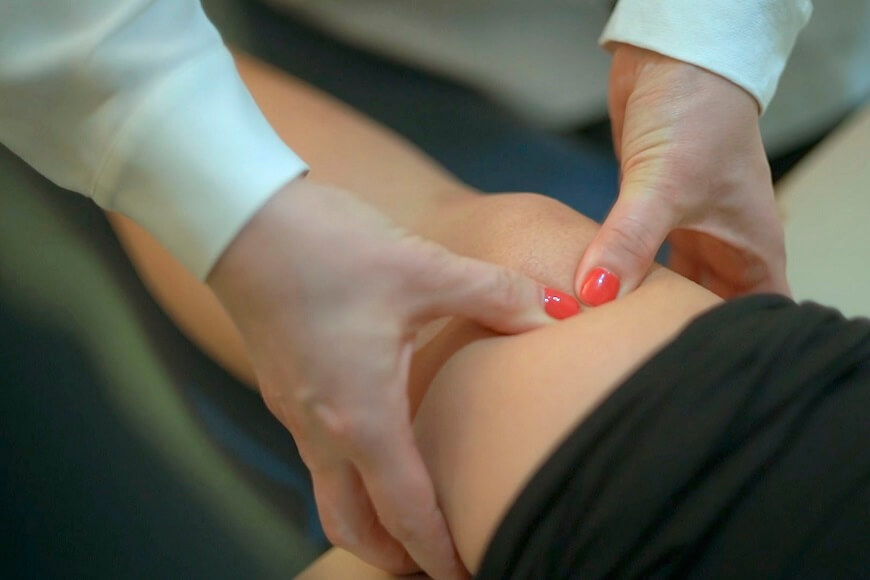Working Time
- Mon-Thu 08:00 - 20:00
Friday 07:00 - 22:00
Saturday 08:00 - 18:00
Contact Info
-
Phone: 011 240 40 46
011 407 82 31
064 258 89 85 - info@ffb.rs
Ask the Experts
Knee Pain Therapy

Knee joint
The knee joint is the largest joint in the human body that bears the greatest load. The knee is the joint that connects the thighs to the lower leg and consists of two articulations: one between the femur and the tibia and one between the femur and the patella. The knee is a very complex joint that allows for flexion, extension, as well as slight medial and lateral rotation.
Causes and symptoms
There are several possible causes for knee pain:
- Sprained ligaments - in the case of sprained ligaments, moderate pain is felt on the inside of the knee, without significant swelling and bruising. The knee is stable. When pressing, the pain increases;
- Partial tearing of ligaments - there is pain that increases with movement. Appears The knee is stable. With this type of injury, stopping movements, changes in direction and the effects of external forces that the muscles cannot absorb because they are too sudden or strong are particularly dangerous;
- Complete tearing of ligaments - severe pain occurs. Walking is significantly more difficult. Swelling is present. The knee is unstable. In most cases, the anterior cruciate ligament ruptures;
- Meniscus injury - ear injury occurs with frequent traumas and with larger rotational movements of the knee. The injury can occur during prolonged squatting, i.e. when the knee is more bent. In addition to pain, limited movement in the knee, possible redness and swelling, one of the reliable symptoms that indicate a meniscus injury is the inability to fully straighten the leg.
Knee pain is most often caused by sports activities. Due to the overstrain of the ligaments during a bad landing, serious knee injuries can occur. Ligament injuries occur when the stability position of the knee joint is exceeded. A sudden change of direction when running, landing, and the like have the consequence of tearing the anterior cruciate ligament ACL.
Very often, a loud sound is heard with a knee injury, which is a sure sign that a serious knee injury has occurred. Athletes very often finish a sports match after such injuries, but when the joint cools down, they feel severe pain and difficulty moving.
Knee diseases
- Arthrosis - loss and damage of cartilage;
- Arthritis - inflammation of the joints. Arthritis is a general name for more than 100 diseases, which are associated with joint inflammation. The three most common forms of arthritis include osteoarthritis, rheumatoid arthritis, and gout. Osteoarthritis is the most common type of arthritis and is caused by wear and tear of joint surfaces. One of the joints that is most often affected by arthritis is the knee, and osteoarthritis of the knee is also called gonarthrosis;
- Gonarthrosis - in gonarthrosis, the articular cartilage in the knee is damaged. The articular cartilage is a smooth surface that covers the end parts of the bones and has the role of cushioning movements in the joint and enabling smooth movements in the knee joint;
- Crepitations - clicking and scratching from the joints when moving the joint;
- Contractures in the joint itself - limitation of joint mobility in some or all directions, which can occur due to various pathological processes in the joint itself or the surrounding tissue. The limitation is permanent and refers to active and passive movements in the joint.
Treatment of knee pain
Knee injuries must first be diagnosed and determined by a clinical examination by a specialist doctor. In addition to the clinical examination, it is necessary to perform an X-ray of the knee, an ultrasound scan and, if necessary, an NMR (magnetic resonance) of the knee.
It is very important to start knee physical therapy as soon as the first symptoms of knee pain appear. Please call us as soon as possible when you feel pain in your knee that has been bothering you for more than two days.
Treatment of shoulder pain is most often carried out by applying:
- Laser therapy - application of a laser as a source of coherent monochromatic light, a highly directed beam, affects the faster recovery of the shoulder. The laser represents stimulated radiation where all emitted photons are equal, have the same wavelength, the same direction of movement, so the resulting light is monochromatic, coherent and directional;
- Ultrasound therapy - penetrates deep into the tissue and is most absorbed in ligaments and tendons (structures with a high collagen content);
- Kinesitherapy - the application of movement in the treatment of patients. Kinesitherapy is the basis of functional treatment and training of patients after injuries and painful conditions. Treatment of injuries in rehabilitation cannot be imagined without kinesitherapy.
- Electrotherapy - has an analgesic effect on pain, which means that it reduces pain by stimulating receptors in the skin and releasing endogenous opioids, as well as by improving blood and lymph circulation.
- Cryotherapy – cryomassage of the injured region, cooling of painful tissue and pain relief.
Free Viber consultations with a specialist doctor
For a free consultation with a specialist doctor, please call us or send a Viber message to the following number: 064 258 89 85.






